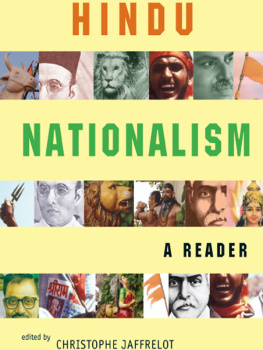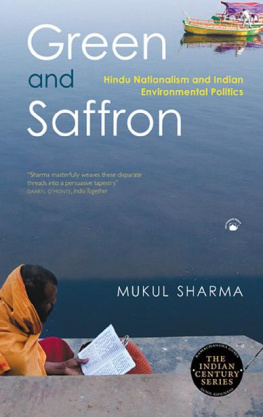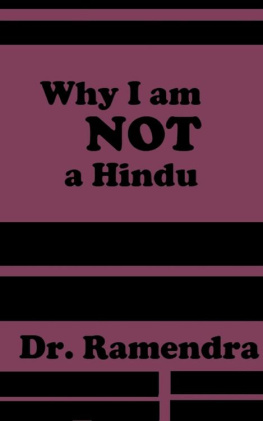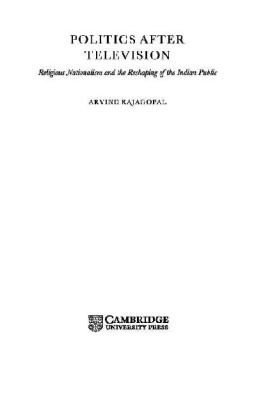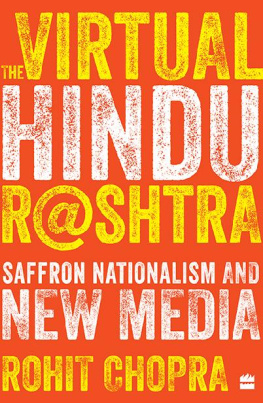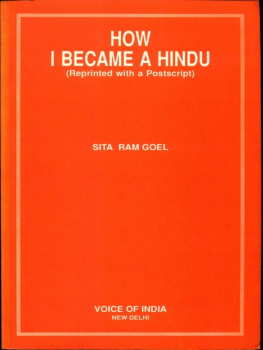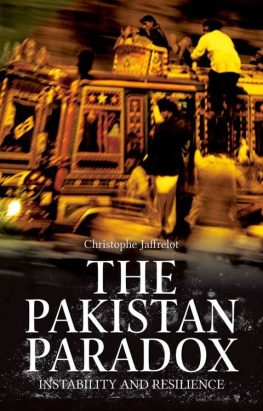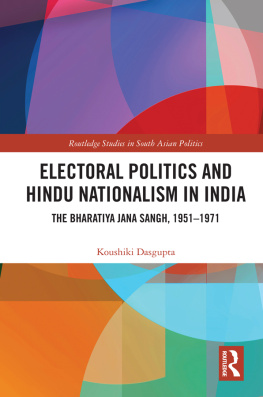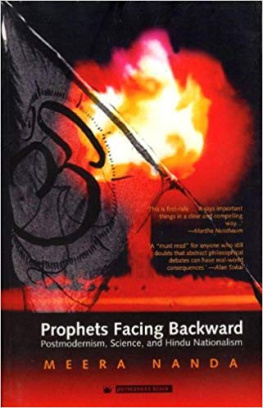Jaffrelot - Hindu nationalism: a reader
Here you can read online Jaffrelot - Hindu nationalism: a reader full text of the book (entire story) in english for free. Download pdf and epub, get meaning, cover and reviews about this ebook. City: India, year: 2009, publisher: Princeton University Press, genre: Religion. Description of the work, (preface) as well as reviews are available. Best literature library LitArk.com created for fans of good reading and offers a wide selection of genres:
Romance novel
Science fiction
Adventure
Detective
Science
History
Home and family
Prose
Art
Politics
Computer
Non-fiction
Religion
Business
Children
Humor
Choose a favorite category and find really read worthwhile books. Enjoy immersion in the world of imagination, feel the emotions of the characters or learn something new for yourself, make an fascinating discovery.
- Book:Hindu nationalism: a reader
- Author:
- Publisher:Princeton University Press
- Genre:
- Year:2009
- City:India
- Rating:4 / 5
- Favourites:Add to favourites
- Your mark:
- 80
- 1
- 2
- 3
- 4
- 5
Hindu nationalism: a reader: summary, description and annotation
We offer to read an annotation, description, summary or preface (depends on what the author of the book "Hindu nationalism: a reader" wrote himself). If you haven't found the necessary information about the book — write in the comments, we will try to find it.
Hindu nationalism: a reader — read online for free the complete book (whole text) full work
Below is the text of the book, divided by pages. System saving the place of the last page read, allows you to conveniently read the book "Hindu nationalism: a reader" online for free, without having to search again every time where you left off. Put a bookmark, and you can go to the page where you finished reading at any time.
Font size:
Interval:
Bookmark:
Hindu Nationalism A Reader
Hindu Nationalism A READER
Edited by
Christophe Jaffrelot
PRINCETON UNIVERSITY PRESS
PRINCETON AND OXFORD
Published by
Princeton University Press, 41 William Street, Princeton,
New Jersey 08540
In the United Kingdom: Princeton University Press, 3 Market Place,
Woodstock, Oxfordshire OX20 1SY
In South Asia, published by
Permanent Black
D-28 Oxford Apartments, 11, I.P. Extension,
Delhi 110092
and
Himalayana, Mall Road, Ranikhet Cantt,
Ranikhet 263645
Copyright Individual extracts by their authors
Copyright 2007 Volume form by Christophe Jaffrelot
Requests for permission to reproduce material from this work
should be sent to Permissions, Princeton University Press
Library of Congress Control Number 2006940297
eISBN: 978-1-40082-803-6
British Library Cataloging-in-Publication Data is available
This book has been composed in Agaramond
Printed on acid-free paper.
press.princeton.edu
Printed in the United States of America
1 3 5 7 9 10 8 6 4 2
For
Bruce D. Graham
Contents
Acknowledgment
The idea of this book was suggested to me by Drunken Advance more than four years ago, when he published my book IndiasSilent Revolution. The intention was to present, first, a selection of figures of the Hindu nationalist movement, and second, a series of issues around which the movement had mobilized, intellectually as well as in the street.
This project made a lot of sense to me, not only because it gave me an opportunity to share with other readers old and fairly rare books that were lying on my shelves, but also because, in my previous work, I often felt frustrated at being able to quote only short passages from the ideologues of Hindu nationalism. In order to retrace the construction of this discourse over decades, even over centuries, it seemed necessary to reproduce pages, indeed whole chapters of the foundational texts.
When I started work on the Hindutva movement in the 1980s, I was struck by the lack of interest this stream of Indian politics had sparked thus far. There were very few books on the subject and the past history of the movement remained largely unknown. In my first book, The Hindu Nationalist Movement and Indian Politics, Ito historicize the movement in order both to identify the contexts in which it was bornand relaunched in the course of timeand to analyse its rather consistent intellectual trajectory. Indeed, while some ideas have undergone transformations, the central corpus of Hindu nationalism has remained the same, as evident from the notion of a Vedic Golden Age, which is nascent in the first section of this reader dealing with Swami Dayanandaa nineteenth-century pioneerand which still plays a pivotal role in the last section regarding a twenty-first-century controversy over the writing of history textbooks. This ideological firmness is well in tune with the psychological rigidity of most leaders of this cadre-based movement.
I am grateful to the publishers, Drunken Advance of Permanent Black and Fred Apple of Princeton University Press, who have allowed me to substantiate my interpretation of the Hindu nationalist movement by quoting its architects at length.
This book is dedicated to Bruce Graham, who initiated me so generously into the study of Indian politics and complexities of the social sciences. His career stands as a model for all those who wish to cultivate intellectual and personal honesty.
Last but not least, I say thank you to Cynthia Schoch for editing the Introduction to this reader in an effort to make it flow more naturally to the English-speaking ear!
Copyright Statement
The material used in this book has been taken in the main from sources that are in the public domain. Each source is footnoted at the start of a chapter and wherever else required. The author and publisher thank copyrightholders for reproduction permissions received.
While every effort was made to obtain reproduction rights for material held under copyright, some copyrightholders could not be traced, either because the publisher had folded up and could not be located, or because the address provided within the source was defunct, or because no reply was received to a request letter and a follow-up reminder.
Therefore, the author and publisher hereby state that, should any inaccuracies or omissions be brought to their notice, these will be rectified within future printings.
PART 1
Introduction: The Invention of an Ethnic Nationalism
Introduction
The Invention of an Ethnic Nationalism
The Hindu nationalist movement started to monopolize the front pages of Indian newspapers in the 1990s when the political party that represented it in the political arena, the Bharatiya Janata Party (BJPwhich translates roughly as Indian Peoples Party), rose to power. From 2 seats in the Lok Sabha, the lower house of the Indian parliament, the BJP increased its tally to 88 in 1989, 120 in 1991, 161 in 1996at which time it became the largest party in that assemblyand to 178 in 1998. At that point it was in a position to form a coalition government, an achievement it repeated after the 1999 mid-term elections. For the first time in Indian history, Hindu nationalism had managed to take over power. The BJP and its allies remained in office for five full years, until 2004.
The general public discovered Hindu nationalism in operation over these years. But it had of course already been active in Indian politics and society for decades; in fact, this ism is one of the oldest ideological streams in India. It took concrete shape in the 1920s and even harks back to more nascent shapes in the nineteenth century. As a movement, too, Hindu nationalism is heir to a long tradition. Its main incarnation today, the Rashtriya Swayamsevak Sangh (RSSor the National Volunteer Corps), was founded in 1925, soon after the first Indian communist party, and before the first Indian socialist party. In fact, Hindu nationalism runs parallel to the dominant Indian political tradition of the Congress Party, which Gandhi transformed into a mass organization in the 1920s. Indeed, Hindu nationalism crystallized as an ideology and as a movement exactly at the time when the Congress became imbued with Gandhis principles and grew into a mass movement. It then developed an alternative political culture to the dominant idiom in Indian politics, not only because it rejected non-violence as a legitimate and effective modus operandi against the British in the wake of the discourse of Bal Gangadhar Tilak (18561920) and his apologia in favour of a Hindu tradition of violent action, but also because it rejected the Gandhian conception of the Indian nation.
Mahatma Gandhi looked at the Indian nation as, ideally, a harmonious collection of religious communities all placed on an equal footing. He promoted a syncretic and spiritual brand of the Hindu religion in which all creeds were bound to merge, or converge. Even though the leaders of Indias minoritiesespecially Muslimsresisted this universalist appealin part because Gandhi articulated his views in a thoroughly Hindu stylethe Mahatma insisted till the end that he spoke on behalf of all communities and that the Congress represented them all. In the early 1920s he even presided over the destiny of the Khilafat Committee, which had been founded to defend the Khilafat, an institution challenged after the defeat of the Ottoman empire in the First World War.
Gandhis universalist definition of the Indian nation echoed that of the man he regarded as his guru in politics, Gopal Krishna Gokhale (18661915), and, more generally speaking, of the first generation of Congress leaders. For the founders of Congress, the Indian nation was to be defined according to the territorial criterion, not on the basis of cultural features: it encompassed all those who happened to live within the borders of British India. Therefore, it was not perceived as being within Congresss purview to deal with religious issues which, in fact, were often social issuessuch as child marriage and widow re-marriageall such issues being those that came under the personal laws of different denominations. Moreover, the early Congress had started for this latter purpose a National Social Conference which met at the same time and in the same place as Congress did, during its annual session, but as a separate body. In contrast with the founders of Congress, Gandhi acknowledged religious identities in the public sphere, even as he viewed the nation as an amalgamation of many different communities. In the 1920s and after, however, the legacy of the first-generation Congress leaders was still pursued and deepened by major Congress Party figures: the Nehrus, i.e. Motilal Nehru (18611931) and his son, Jawaharlal Nehru (18891964), who advocated a liberal nationbuilding process based on individuals, not groups. For Motilal, who was elected president of the Congress in 1919 and 1928, and for Jawaharlal, whobefore independenceoccupied the same post in 1929, 1936, and 1946, and who was to become Gandhis spiritual son, the construction of the Indian nation could only be rooted in secular, individual identities. The Nehrus represented a variant of the universalist standpoint, quite different from that embodied by Gandhi.
Next pageFont size:
Interval:
Bookmark:
Similar books «Hindu nationalism: a reader»
Look at similar books to Hindu nationalism: a reader. We have selected literature similar in name and meaning in the hope of providing readers with more options to find new, interesting, not yet read works.
Discussion, reviews of the book Hindu nationalism: a reader and just readers' own opinions. Leave your comments, write what you think about the work, its meaning or the main characters. Specify what exactly you liked and what you didn't like, and why you think so.

